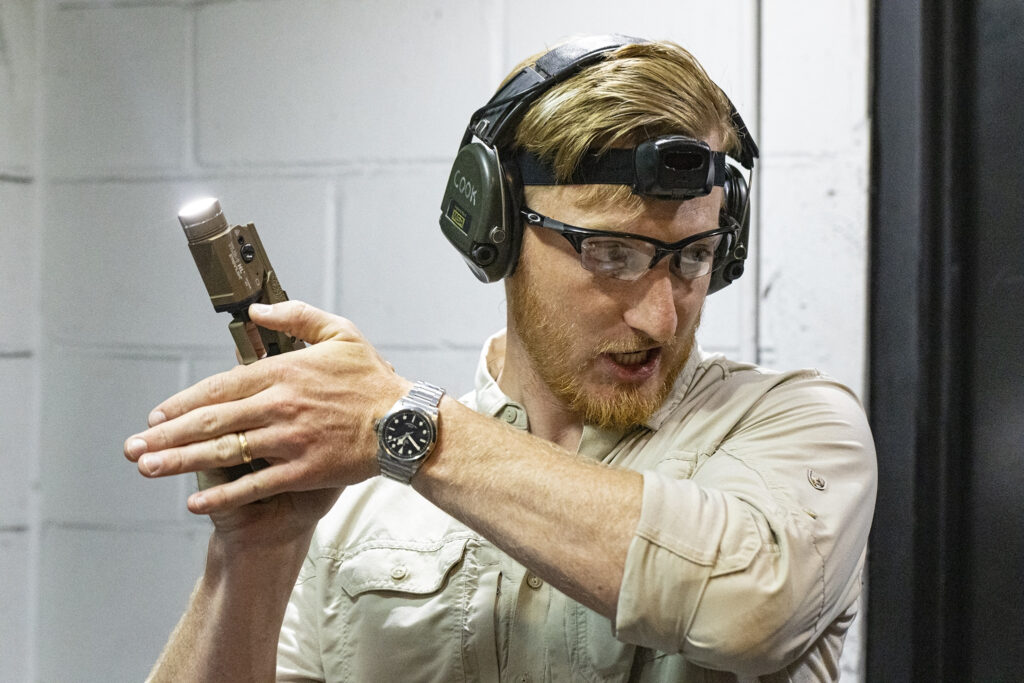The internet has been awash with debates over the last several years as to the necessity of weapon-mounted lights on concealed carry pistols. Should you carry your pistol ready for low-light scenarios? Or not? That is the question.

Low-Light Pistol Training with Odyssey Training and Consulting
Having lived and worked my entire life in urban or suburban areas, and having had a couple of what I call “non-events” (situations that got my hackles up and very well could have been a setup/interview but didn’t end up degrading to a point where force was needed), I’ve personally never experienced a compelling argument for a light specifically on a carry gun.
Advertisement — Continue Reading Below
A local range has done some low-light “skills and drills” nights, where we mocked up some situations with various lighting conditions and played around with various hand and gun lights. But that has been the extent of it.
Up to this point, I hadn’t prioritized a low-light class, but I realized that I should test my theories more seriously to see how well they held up. When Chris Cook of Odyssey Training approached me about auditing his Low-Light Pistol class that was coming to town, I obviously jumped at the opportunity.
The course started off with a few hours in the classroom going over relevant terminology as well as real-world examples of light usage (mostly by officers, since that’s what tends to get caught on camera), to help frame the problem that we as Civilian Defenders are likely to encounter.
Advertisement — Continue Reading Below

On the Range
Once we hit the range, there was the requisite warm-up/skill evaluation. Chris likes using the Bill Drill since it highlights grip, presentation, trigger control, and recoil management. His guidance is that your 1-handed Bill Drill splits should be no more than 2X that of your freestyle Bill Drill. One-handed shooting gets introduced early on in the day since the support hand will soon be tasked with other things. Namely, the three major hand light positions that Chris favors.
A combination of Modified FBI, Temple Index (higher than Neck Index), and Harries gives the shooter a good range of mobility, stability, and alignment of the light.
Advertisement — Continue Reading Below
After lunch, we then progressed to manipulations with the weapon-mounted light, Chris’ preferred activation methods (he and I both agree with the late Paul Gomez’s philosophy that “I only want my trigger finger doing one thing, and that’s adjusting the volume on the gun”). This was my first time really trying to activate a gun-light from the holster, and it was a lot more finicky than I had expected. Chris’s “standard” for gun lights is that the draw w/activation should add no more than 1/2 a second to your draw to first hit.

We worked a few more exercises, including moving around barricades to force the use of the various different techniques and Centrifuge Training’s “Third Grade Math.” Then, the day culminated with a game Chris calls “Flashlight Tag.” It’s basically a rudimentary force-on-force exercise with a flashlight instead of a UTM gun. It helped highlight how to use lighting conditions to your advantage and how to control other people with light.
Advertisement — Continue Reading Below
What the Class Is:
This is a fantastic introduction to the skills necessary for the concealed carrier to effectively, safely, and legally apply deadly force in a low-light environment. It also affords a great opportunity to shake out your current gear and assumptions, to see how well they hold up to testing.
What the Class Isn’t:
This is not an introductory class. Students need to have their gun handling locked in tight, including holster work. Nothing was done in pitch black, but you find out quickly how much you rely on sight when holstering your pistol (especially ensuring there are no obstructions in the holster). There’s enough material that requires active mental engagement that basic skills should be deeply ingrained already to avoid overload.

Advertisement — Continue Reading Below
As always, I shamelessly steal the Short-Barreled Shepherd’s 3×3 Course Review template:
Top 3 Topics Covered:
- The five uses of light for the concealed carrier
- Handheld & weapon-mounted techniques & positions (Mod FBI, Temple Index, Harries)
- How your environmental factors will affect your light usage (like how barriers can reflect light back at you)
Top 3 Takeaways:
- The weapon-mounted light is the most complex to employ, with the narrowest utility for the concealed carrier (you’re far more likely to need the light well before you need the gun)
- I really liked how Chris quantified “acceptable” skill degradation w/par times when it came to splits & draw times (one-handed shooting & activating the light on the draw)
- How different beam designs can either facilitate or complicate different shooting positions. (Lights with a tight hot-spot and minimal spill require far more precise alignment when shooting from FBI & Temple Index especially)
3 Things I’ll be Doing Differently:
- I need to spend a lot more time working Harries and Modified FBI
- I need to spend a lot more time working with my Cloud MCH, because of its tighter beam pattern. My Stiletto Pro is far more forgiving.
- I’ll be putting an even taller ND Guard on my Cloud MCH. There were a couple of times where I inadvertently double-punched that light because it was easier to activate than I realized.
photo credit to Mike Branson Photography
Advertisement — Continue Reading Below















